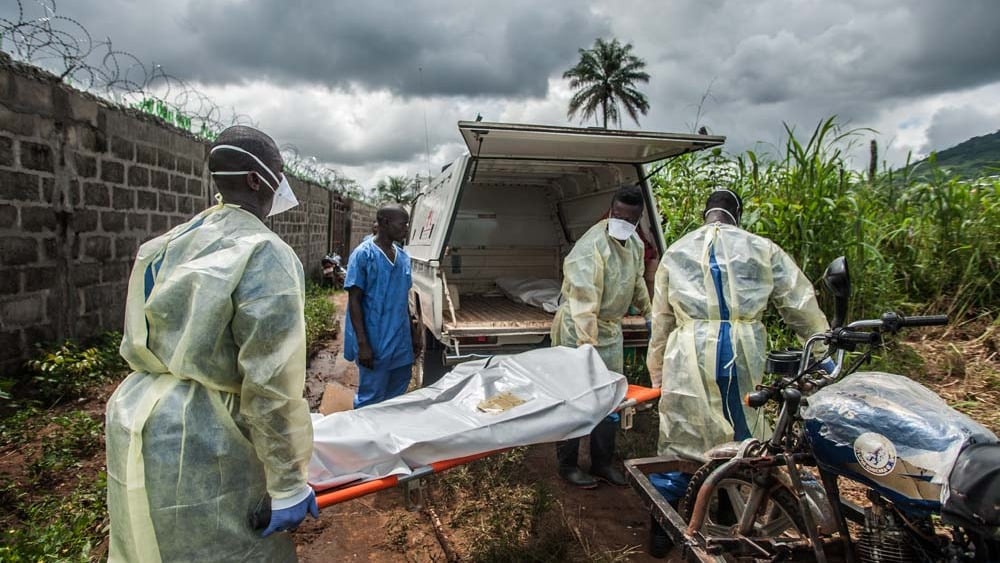Bird flu is back. Chinese authorities are closing live poultry markets as H7N9 courses through the country, infecting 192 and killing 79 in January alone.
So far, this strain of avian flu appears to have been transmitted only through contact with live poultry, but there’s always a fear it will mutate and start passing between humans. That’s what really scares experts: the possibility of a sudden change that triggers faster spread between humans and leads to a pandemic.
A disease doesn’t count as a pandemic until it spreads worldwide – Ebola killed more than 11,000 people across West Africa before it was brought under control, and that was just an epidemic. The most modern pandemics include the Spanish influenza, circa 1918 (as many as 50 million killed), and HIV/AIDS (35 million dead).
As Chinese officials attempt to stem the latest bird flu outbreak, global public health officials are racing to get ahead of what they call the next “big one”: a disease that will kill tens of millions. It’s all about preparedness, and a large part of that is spotting outbreaks early, so action can be taken to contain any situation before it spirals out of control.
It’s anyone’s guess when and where the next major epidemic – or pandemic – might emerge. It could be a mutated version of avian flu, or perhaps something completely unseen before, like the mysterious illness with Ebola-like symptoms that struck out of the blue in South Sudan last year.
Here are a few more possibilities worth keeping an eye on:
Crimean-Congo haemorrhagic fever
When a patient in Madrid died last September of a disease called Crimean-Congo haemorrhagic fever, there was no shortage of headlines about the “new” deadly virus. But the disease has actually been around for years – it got the first part of its name when first reported in Crimea in 1944, and the second thanks to a 1969 spotting in Congo.
The last two words of the disease, abbreviated as CCHF, speak to the symptoms: fever, muscle aches, nausea, diarrhoea, bruising and bleeding (the list goes on), and eventually death in the second week of illness – about 30 percent of patients (sometimes more) succumb to the virus.
CCHF is found pretty much everywhere south of the 50th parallel north: Africa, the Balkans, the Middle East, and Asia. Humans tend to contract the virus through contact with the blood of an infected animal (itself having been bitten by infected ticks) – vets, people working in slaughterhouses, and farmers are typically most at risk.
Once in humans, the virus can be spread through contact with blood, secretions, bodily fluids, and the like. It has been contracted in hospitals thanks to poor sterilisation of equipment and reuse of needles.
The virus bothers researchers and doctors for a number of reasons, one of them cultural: it’s endemic in some Muslim countries where large-scale animal slaughter is part of celebrating (and feasting) for the holiday of Eid al-Adha.
Doctors in Pakistan, for example, have warned of a potential health catastrophe unless slaughtering practices change, as the feasting holiday will be in the summer for the next 10-15 years, coinciding with tick season and CCHF prevalence.
There are similar concerns in Afghanistan, where public health officials have been warning the public about using gloves and other protective clothing when handling animals.
There is no vaccine for Crimean-Congo, and there is no cure, although antiviral drugs have shown some promise.
Nipah virus
This one’s got a Hollywood hook: The 2011 film Stephen Soderbergh film Contagion is reportedly based on it. Spoiler alert. In the movie, Nipah causes a global pandemic. In reality, we’re far from that.
But the way Nipah got going in real life is paralleled in the film: Thanks to drought, deforestation and wildfire, large fruit bats that carry the virus found their natural habitats in Malaysia destroyed. So they moved to fruit trees that happened to be in fairly close proximity to pig farms.
The pigs ate fruit contaminated by bat urine and saliva, the virus spread quickly among livestock, and again farm workers were the first hit. This first outbreak in Malaysia in the late 1990s saw the country cull more than one million pigs: a major hit to the economy.
In its first appearance, Nipah killed 105 of 256 known infected people.
But humans can also get Nipah by drinking raw palm date sap, a delicacy in Bangladesh. It is believed to be the cause of regular seasonal outbreaks in that country. When the sap is harvested, it has already been infected by bats in the trees.
Nipah scares researchers because it kills quickly – nausea, fever, and vomiting, patients progress to a coma within 24-48 hours, and then die. It has also spread swiftly from rural areas to cities.
Once in humans, the virus is found in saliva, so it can kill caregivers and family members who share utensils and glasses, or hug and kiss their sick family members.
Middle East Respiratory Syndrome (MERS)
Bandied about as the next pandemic possibility for a while, MERS was first reported in Saudi Arabia in 2012, although looking back researchers believe there were cases the same year in Jordan.
It’s deadly – a reported 36 percent of patients die – and looks to have come to humans via bats, again. There’s a pattern here: Bats carry a long list of killer viruses and likely triggered the Ebola outbreak as well as SARS and others.
MERS causes fever, cough, shortness of breath, and in more than one third of patients, death. A 2015 outbreak in South Korea killed 36, and caused serious panic. Thousands of schools were closed, and many businesses were hit hard as people were wary even of going outside, and many others were quarantined.
While MERS is deadlier than its cousin SARS, it is also less contagious. It is spread through close contact with an infected person, and most transmissions have been in healthcare settings. There’s no real evidence that it’s gone airborne – that’s always a major fear – but the possibility hasn’t been completely ruled out.
For now, there’s no reason to panic about MERS, but it’s always a worry during the annual Hajj pilgrimage to Muslim holy sites in Saudi Arabia, which sees some two million people converge in the country with the most cases.
Like the other diseases mentioned here, there’s no vaccine and there’s no treatment – it’s all about hygiene.
There are plenty of other scary killers out there, and researchers are both tracking the movement of viruses between species and attempting to figure out a key plot point: why exactly a virus goes airborne. One last top tip: keep a particular eye on influenza. It’s not exotic and everyone knows its name, but some form of the flu could easily become the next “big one”. Oh yes, and be careful of bats.
(TOP PHOTO: Ebola burial teams in Sierra Leone, 2015. Aurelie Marrier d'Unienville/IRIN)
as/ag






